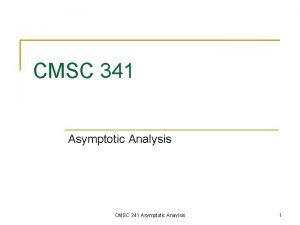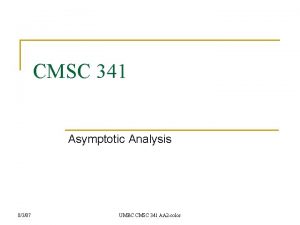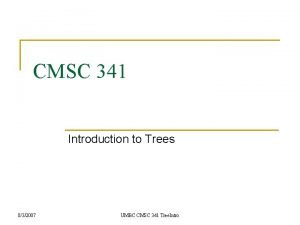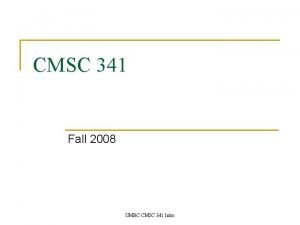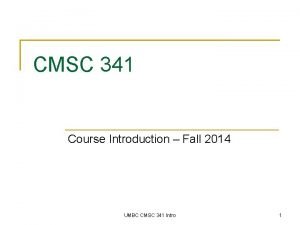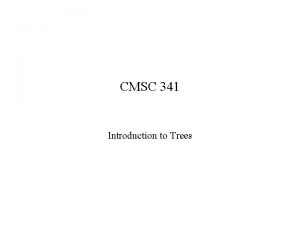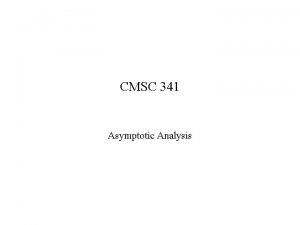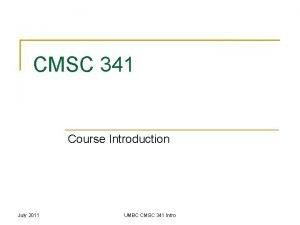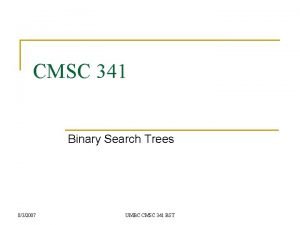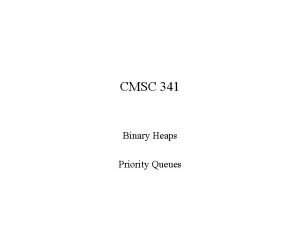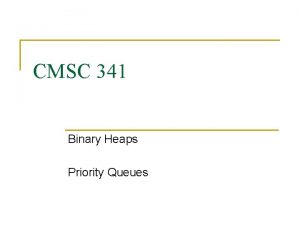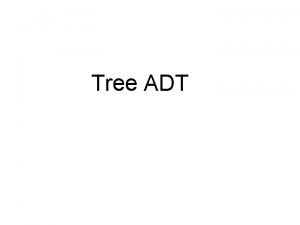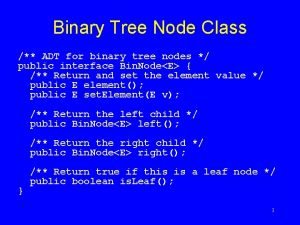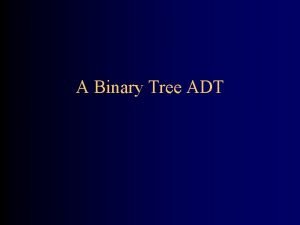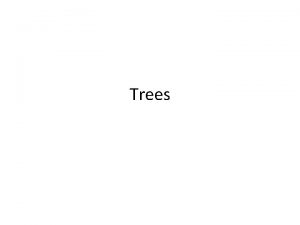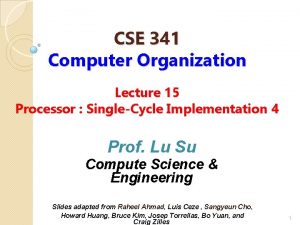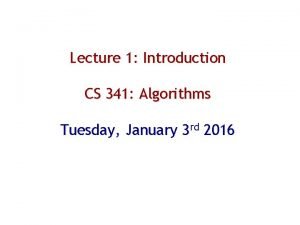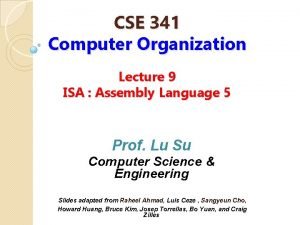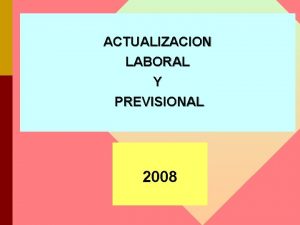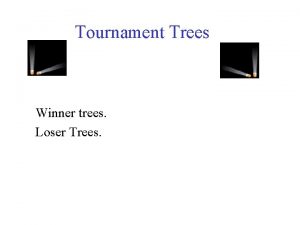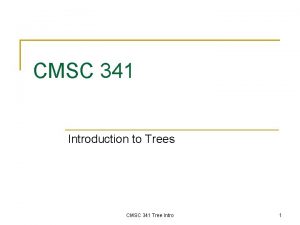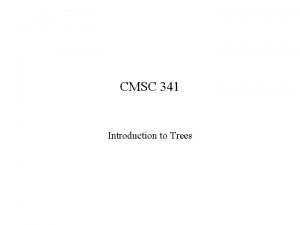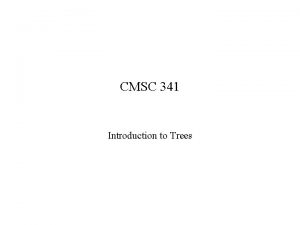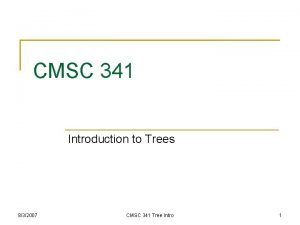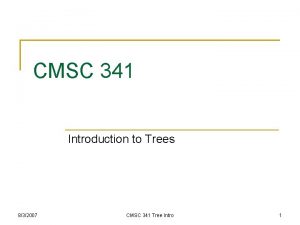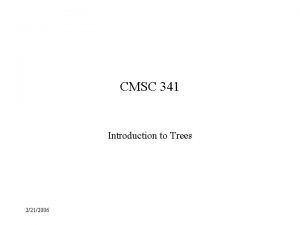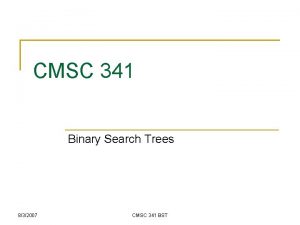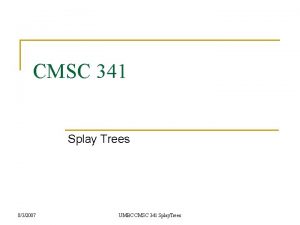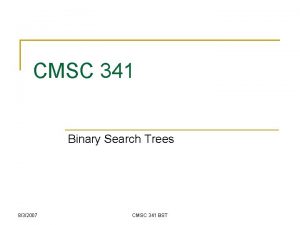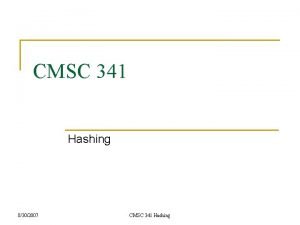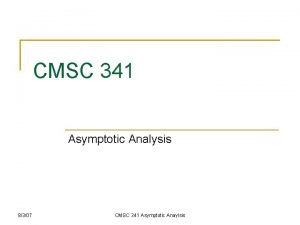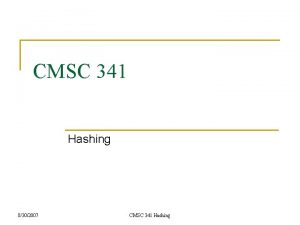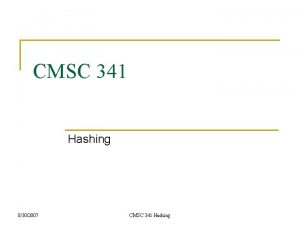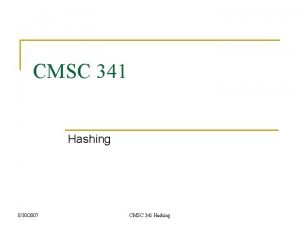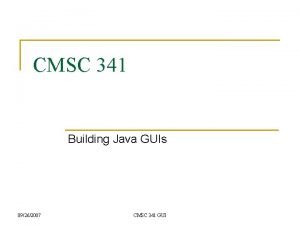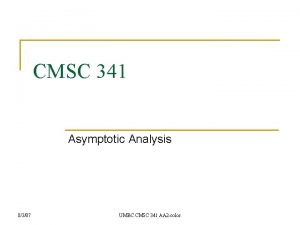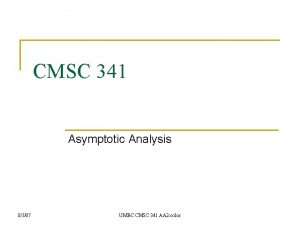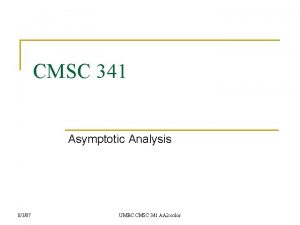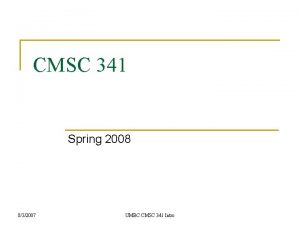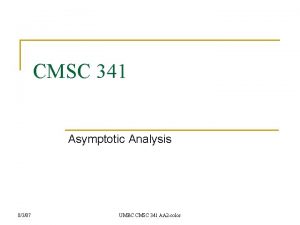CMSC 341 Introduction to Trees Tree ADT Tree
































- Slides: 32

CMSC 341 Introduction to Trees

Tree ADT Tree definition – A tree is a set of nodes. – The set may be empty – If not empty, then there is a distinguished node r, called root and zero or more non-empty subtrees T 1, T 2, … Tk, each of whose roots are connected by a directed edge from r. Basic Terminology – Root of a subtree is a child of r. R is the parent. – All children of a given node are called siblings. – A leaf (or external) node has no children. – An internal node is a node with one or more children 10/15/2021 2

More Tree Terminology A path from node V 1 to node Vk is a sequence of nodes such that Vi is the parent of Vi+1 for 1 i k. The length of this path is the number of edges encountered. The length of the path is one less than the number of nodes on the path ( k – 1 in this example) The depth of any node in a tree is the length of the path from root to the node. All nodes of the same depth are at the same level. The depth of a tree is the depth of its deepest leaf. The height of any node in a tree is the length of the longest path from the node to a leaf. The height of a tree is the height of its root. If there is a path from V 1 to V 2, then V 1 is an ancestor of V 2 and V 2 is a descendent of V 1. 10/15/2021 3

Tree Storage A tree node contains: – Element – Links • to each child • to sibling and first child 10/15/2021 4

Binary Trees A binary tree is a rooted tree in which no node can have more than two children AND the children are distinguished as left and right. A full BT is a BT in which every node either has two children or is a leaf (every interior node has two children). 10/15/2021 5

FBT Theorem: A FBT with n internal nodes has n+1 leaf nodes. Proof by induction: Base case: BT of one node (the root) has: zero internal nodes one external node (the root) Inductive Assumption (assume for n): – All FBT of up to and including n internal nodes have n+1 external nodes. 10/15/2021 6

Proof (cont) Inductive Step (prove for n+1): – Let T be a FBT of n internal nodes. – It therefore has n+1 external nodes. – Enlarge T by adding two nodes to some leaf. These are therefore leaf nodes. – Number of leaf nodes increases by 2, but the former leaf becomes internal. – So, • # internal nodes becomes n+1, • # leaves becomes (n+1)+1 = n+2 10/15/2021 7

Perfect Binary Tree A perfect BT is a full BT in which all leaves have the same depth. 10/15/2021 8

PBT Theorem: The number of nodes in a PBT is 2 h+1 -1, where h is height. Proof: Notice that the number of nodes at each level is 2 l. So the total number of nodes is: Prove this by induction: Base case: 10/15/2021 9

Proof of PBT Theorem(cont) Assume true for all h H Prove for H+1: 10/15/2021 10

Other Binary Trees Complete Binary Tree A complete BT is a perfect BT except that the lowest level may not be full. If not, it is filled from left to right. Augmented Binary Tree An augmented binary tree is a BT in which every unoccupied child position is filled by an additional “augmenting” node. 10/15/2021 11

Path Lengths The internal path length of a rooted tree is the sum of the depths of all of its nodes. The external path length of a rooted tree is the sum of the depths of all the null pointers. There is a relationship between the IPL and EPL of Full Binary Trees. If ni is the number of internal nodes in a FBT, then EPL(ni) = IPL(ni) + 2 ni Example: ni = EPL(ni) = IPL(ni) = 2 ni = 10/15/2021 12

Proof of Path Lengths Prove: EPL(ni) = IPL(ni) + 2 ni by induction Base: ni = 0 (single node, the root) EPL(ni) = 0 IPL(ni) = 0; 2 ni = 0 0 = 0 + 0 Assume for N: True for all FBT with ni < N Prove for N+1: Let ni. L, ni. R be # of int. nodes in L, R subtrees. ni. L + ni. R = N - 1 ==> ni. L < N; ni. R < N EPL(ni. L) = IPL(ni. L) + 2 ni. L EPL (ni. R) = IPL(ni. R) + 2 ni. R EPL(ni) = EPL(ni. L) + EPL(ni. R) + ni. L + 1 + ni. R + 1 IPL(ni) = IPL(ni. L) + IPL(ni. R) + ni. L + ni. R EPL(ni) = IPL(ni) + 2 ni 10/15/2021 13

Traversal Inorder Preorder Postorder Levelorder 10/15/2021 14

Constructing Trees Is it possible to reconstruct a BT from just one of its preorder, inorder, or post-order sequences? 10/15/2021 15

Constructing Trees (cont) Given two sequences (say pre-order and inorder) is the tree unique? 10/15/2021 16

Tree Implementations What should methods of a tree class be? 10/15/2021 17

Tree class template <class Object> class Tree { public: Tree(const Object ¬. Fnd); Tree (const Tree &rhs); ~Tree(); const Object &find(const Object &x) const; bool is. Empty() const; void print. Tree() const; void make. Empty(); void insert (const Object &x); void remove (const Object &x); const Tree &operator=(const Tree &rhs); 10/15/2021 18

Tree class (cont) private: Tree. Node<Object> *root; const Object ITEM_NOT_FOUND; const Object &element. At(Tree. Node<Object> *t) const; void insert (const Object &x, Tree. Node<Object> * &t) const; void remove (const Object &x, Tree. Node<Object> * &t) const; Tree. Node<Object> *find(const Object &x, Tree. Node<Object> *t) const; void make. Empty(Tree. Node<Object> *&t) const; void print. Tree(Tree. Node<Object *t) const; Tree. Node<Object> *clone(Tree. Node<Object> *t)const; }; 10/15/2021 19

Tree Implementations Fixed Binary – element – left pointer – right pointer Fixed K-ary – element – array of K child pointers Linked Sibling/Child – element – first. Child pointer – next. Sibling pointer 10/15/2021 20

Tree. Node : Static Binary template <class Object> class Binary. Node { Object element; Binary. Node *left; Binary. Node *right; Binary. Node(const Object &the. Element, Binary. Node *lt, Binary. Node *rt) : element (the. Element), left(lt), right(rt) {} friend class Tree<Object>; }; 10/15/2021 21

Find : Static Binary template <class Object> Binary. Node<Object> *Tree<Object> : : find(const Object &x, Binary. Node<Object> *t) const { Binary. Node<Object> *ptr; if (t == NULL) return NULL; else if (x == t->element) return t; else if (ptr = find(x, t->left)) return ptr; else return(ptr = find(x, t->right)); } 10/15/2021 22

Insert : Static Binary 10/15/2021 23

Remove : Static Binary 10/15/2021 24

Tree. Node : Static K-ary template <class Object> class Kary. Node { Object element; Kary. Node *children[MAX_CHILDREN]; Kary. Node(const Object &the. Element); friend class Tree<Object>; }; 10/15/2021 25

Find : Static K-ary template <class Object> Kary. Node<Object> *Kary. Tree<Object> : : find(const Object &x, Kary. Node<Object> *t) const { Kary. Node<Object> *ptr; if (t == NULL) return NULL; else if (x == t->element) return t; else { i =0; while ((i < MAX_CHILDREN) && !(ptr = find(x, t->children[i])) i++; return ptr; } } 10/15/2021 26

Insert : Static K-ary 10/15/2021 27

Remove : Static K-ary 10/15/2021 28

Tree. Node : Sibling/Child template <class Object> class KTree. Node { Object element; KTree. Node *next. Sibling; KTree. Node *first. Child; KTree. Node(const Object &the. Element, KTree. Node *ns, KTree. Node *fc) : element (the. Element), next. Sibling(ns), first. Child(fc) {} friend class Tree<Object>; }; 10/15/2021 29

Find : Sibling/Child template <class Object> KTree. Node<Object> *Tree<Object> : : find(const Object &x, KTree. Node<Object> *t) const { KTree. Node<Object> *ptr; if (t == NULL) return NULL; else if (x == t->element) return t; else if (ptr = find(x, t->first. Child)) return ptr; else return(ptr = find(x, t->next. Sibling)); } 10/15/2021 30

Insert : Sibling/Child 10/15/2021 31

Remove : Sibling/Parent 10/15/2021 32
 Cmsc 341
Cmsc 341 Cmsc 341
Cmsc 341 Cmsc 341
Cmsc 341 Cmsc 341 umbc
Cmsc 341 umbc Umbc cmsc 341
Umbc cmsc 341 Cmsc 341
Cmsc 341 Cmsc 341
Cmsc 341 Cmsc 341 umbc
Cmsc 341 umbc Cmsc 341 umbc
Cmsc 341 umbc Cmsc 341
Cmsc 341 Cmsc 341
Cmsc 341 Tree adt
Tree adt Binary tree adt
Binary tree adt Binary tree adt
Binary tree adt Inorder traversal
Inorder traversal Adt tree
Adt tree Sda hymn 341
Sda hymn 341 Ecma-341
Ecma-341 Hundred thousand ten thousand
Hundred thousand ten thousand Komax 333
Komax 333 Cse 341
Cse 341 341 ces
341 ces Acer predator xr341ck
Acer predator xr341ck O mon sauveur a toi seul
O mon sauveur a toi seul Mgmt 341
Mgmt 341 Ncg 341
Ncg 341 Cs350 uwaterloo
Cs350 uwaterloo Cse 341
Cse 341 Actualizacion 341
Actualizacion 341 Winner tree and loser trees
Winner tree and loser trees Winner tree
Winner tree Loser tree
Loser tree Apple notes
Apple notes
